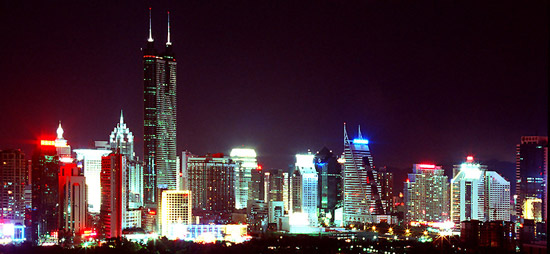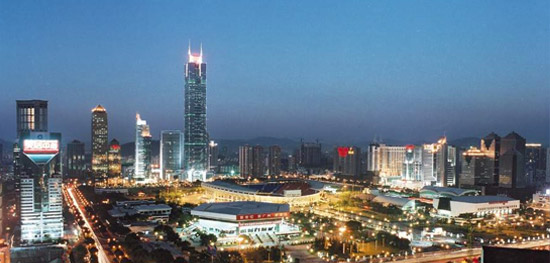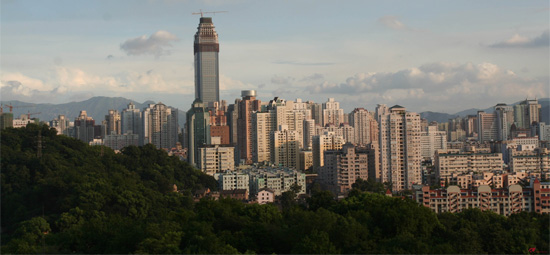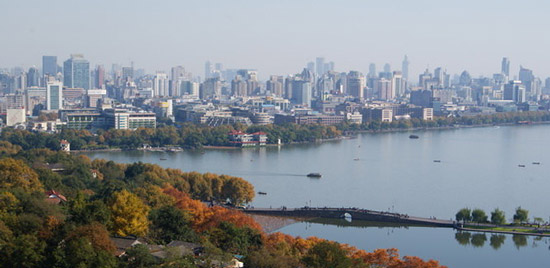China’s Wealthiest Cities 2: The Demographics
Nov. 11 – Yesterday we ran a piece on China’s wealthiest cities by identifying the top 10 cities in China with the highest levels of disposable income. Today we provide a breakdown of the top five: Shenzhen, Shanghai, Guangzhou, Wenzhou and Hangzhou. Tomorrow we will outline Beijing, Suzhou, Dongguan, Tianjin and Wuxi.
Shenzhen: Disposable income RMB28,838

Shenzhen has steadily grown in the past 20 years into a booming metropolitan city. It is located on the mid-southern coastline of Guangdong Province and is the only city neighboring Hong Kong. Shenzhen serves as an important gateway linking Hong Kong and the mainland. Its status as a special economic zone has given it ground-breaking incentives to further attract foreign investment and maintain the policy of one country, two systems.
Fast facts
- Shenzhen manufactures 90 percent of computer keyboards, 90 percent of computer mice, and 70 percent of computer screens sold globally
- Migrant workers account for some 90 percent of Shenzhen’s population
- Per capita GDP is the highest among Chinese cities
- It is the fastest growing city in China for the past 30 years and one of the most rapidly evolving cities in the world
Infrastructure
The city’s fast development over the last two decades has improved infrastructure. Shenzhen has an extensive land, sea and air transportation infrastructure network in addition to only being at a 70 kilometer radius to the key cities of Zhuhai, Hong Kong and Macau.
There are 2,800 kilometers of roads and 200 kilometers of expressways in Shenzhen. There are more than 150 buses traveling between Shenzhen and Guangzhou daily along with 300 buses that shuttle between Shenzhen and Hong Kong.
It is the first city in the country to operate pre high- speed trains along with an extensive railway network. The two major railway lines in China, the Beijing-Guangzhou Line and the Beijing- Kowloon Railway, all converge in the city. Its highway network also connects it to all major cities in the PRD. The newest addition, the Shenzhen Metro Line 4, is already operational with five stops.
The Shenzhen Bao’an International Airport, located 35 kilometers from downtown, is one of the top airports in China with 95 domestic airlines and 14 international airlines.
Shenzhen has benefited from Hong Kong’s reputation in international shipping to become one of China’s top ports. Hong Kong-based Hutchison Whampoa increased its investment in the Yantian West Port Terminals to RMB270.63 million in 2010,a move that will give it strategic access to one of the most important ports in the region. The Shenzhen Bay Port, a border crossing between south of Shenzhen and Hong Kong, has the capacity for two-way daily traffic and passenger flows up to 29,800 vehicles and 30,800 passengers and should increase to some 60,300 vehicles and 61,300 passengers per day by 2016.
The China National Offshore Oil Corp has invested on an integrated gas scheme, the LNG project, in the city with a production capacity of 3.3m t/y. In 2001, BP took a 30 percent stake in the project, which will also take gas from Australia’s North West Shelf. Every year, the Shenzhen reservoir channels a total of 1.1 billion cubic meters of water from the east river to Hong Kong. The Daya Bay Nuclear Power Plant, located in eastern Shenzhen, transmits electricity to Hong Kong. Shenzhen was the 6th Chinese city to have a metro-rail system when it started operations in 2004. So far only two lines are in operation, totaling nearly 25 kilometers of rail linking 22stations.
Economy and investment climate
Shenzhen is the most successful special economic zone in China. It has ambitions to become an international metropolis.
In 2009, GDP was RMB820.123 billion. The city is posing a threat to Guangzhou’s stronghold as the provincial and economic capital of the south of China. Shenzhen has the benefit of its proximity to Hong Kong and cheaper labor wages.
During the same period, per capita income was RMB92,771.The city’s major industries are computer software, IT, microelectronics and components, video and audio products, electromechanical integration, and light industry and energy.
Electronics and telecommunications equipment account for over 90 percent of the total output of Shenzhen’s new and high-tech industries.
The SEZ is a major software development base. Over 90 percent of foreign direct investment is in manufacturing, reflecting the advantages of Shenzhen as an industrial base.
It is estimated that as much as 70 percent of foreign overseas investment in the city comes from Hong Kong. These Hong Kong-funded enterprises in Shenzhen represent 80 percent of the overseas firms in the city. Since the implementation of Closer Economic Partnership Arrangement, trade between both sides has doubled with an average annual growth of 20 percent.
As a manufacturing base for a wide range of industries, Shenzhen uses Hong Kong as a trade platform to expand the global market. On the other hand, foreign companies can supply industrial products to Shenzhen through Hong Kong.
According to sources, China is set to build the largest railway container center in Asia at a cost of US$286.39 million. The railway center will have a total cargo throughput of 2.2-2.5 million TEUs, with direct lines to the country’s major ports: Shanghai, Guangzhou, Shenzhen, Qingdao, Lianyungang and Tianjin.
The city however, does have a number of problems. First, the supply of useable land is running out. Shenzhen has just 200 square kilometers of land left for development and in the city center, as little as 30 square kilometers is available. Secondly, there is a security problem. With a floating population of close to four million, it has not been easy to control the crime rate. However, the city continues to attract ambitious and talented young men and women from all over China; making it the country’s version of the Wild West.
Shanghai: Disposable income RMB28,837

Shanghai is China’s most comprehensive industrial and commercial city, ranking first in population and population density. As the most westernized city in China after Hong Kong, Shanghai is on the cutting edge of China’s race for modernization. Almost a quarter of the world’s construction cranes stand in this city of 18 million. It stands as an international metropolis which has witnessed breathtaking economic development over the last 15 years and shows no signs of slowing down. It is China’s largest commercial and industrial city as well as a popular tourist destination.
Fast facts
- During the development of Pudong from farmland into towering skyscrapers, it was said that over half of the world’s cranes were working in Shanghai
- The Shanghainese dialect is spoken by over 13 million people
- The World Financial Center in Pudong is the third largest skyscraper in the world
- Host of the 2010 Shanghai World Expo
Infrastructure
Shanghai’s transportation infrastructure is constantly trying to keep up with the city’s ever expanding urban population.
Shanghai has six elevated roads, including two ring roads and eighteen expressways. The two main areas, Pudong and Puxi, are linked both by bridges and underground tunnels. There are six national expressways, which connect Shanghai to Beijing and the surrounding region, with plans for an extension to connect Chongming Island to the city center. The recent rise in disposable income means more and more people can afford to buy cars, more so after the government announced tax cuts for first time buyers as part of its stimulus plan in 2009.
The world’s first commercial Maglev railway was opened in Shanghai in 2003. It connects Pudong International Airport with the Longyang Road metro station in less than eight minutes and reaches a maximum speed of 433 kilometers per hour. Two major railway lines intersect in the city, the Jinghu railway connecting Shanghai with Beijing and the Hu Hang railway, which runs to Hangzhou. Shanghai is also famed for its metro system which transports millions of people per day and is in the process of expansion. There are now 13 metro lines in operation as of 2010.
Shanghai has two airports: Pudong International and Hongqiao International. Pudong airport is the third busiest airport in the country after Beijing Capital and Hong Kong Chek Lap Kok.
It only took Shanghai five years to double its cargo handling capacity from 200 to 400 million tons, overtaking Singapore to become the largest port in the world in terms of cargo tonnage. Shanghai has shipping lines around the globe, extending to Europe, America, Australia, Japan and Southeast Asia.
Economy and investment climate
Shanghai’s advantage lies in its links to the Chinese interior and the central government, in addition to strong manufacturing and technology base enabling it to record a double-digit growth for 16 consecutive years since 1992. In 2009, Shanghai’s GDP reached RMB1.49 trillion and per capita income was RMB77,564. Exports reached US$169 billion, an increase of 17.6 percent while imports amounted to US$153 billion in 2008.
The Shanghai Economic Committee cites the manufacturing industry as the key driving force for economic development in Shanghai. The committee has also prioritized the expansion of the modern service industry and the advanced manufacturing industry with the goal of turning Shanghai into one of the four major central business districts by 2020. The city still aims to attract more foreign investment in six service sectors, despite the growing concern that its over-dependency on foreign investment is unbalanced and risky for the city.
Guangzhou: Disposable income RMB28,266

Guangzhou is the capital of Guangdong Province and one of the largest cities in China. It is the transportation, industrial, financial, and trade center of Southern China. The city is also a major deep-water port on the Pearl River Delta, a special economic development zone and an important trading point with Hong Kong.
Fast facts
- Guangzhou has the third highest GDP among Chinese cities
- It has the largest internal trade and distribution center in China; 75 percent of goods are sourced and 70 percent are sold outside Guangzhou
- Is the largest distribution center in China for garments, shoes, toys and gifts; 10 billion pairs of shoes are manufactured and sold around the world each year
Infrastructure
Over the last few years, the Guangzhou government invested a lot of money into the city’s infrastructure. New networks of highway have been constructed in the region and now travel time to most major cities in the region has been significantly reduced.
Expressways connecting various cities in the PRD are now fully operational and contribute to an efficient transport network. There is a long distance bus station that provides buses from Guangzhou to neighboring areas as well as a direct bus from Guangzhou to Hong Kong. Daily buses run between Guangzhou and Shenzhen every 15 to 30 minutes.
Guangzhou railway station located northwest of the city, can be reached easily by public buses.The Beijing-Guangzhou railway line is the main transportation line between South and North China that provides links to a large number of cities. There are railway lines Guangzhou-Maoming and Guangzhou to Shantou that link Guangzhou’s east and west areas. There are also direct trains to Kowloon, Hong Kong that travel from Guangzhou East Railway Station. The Guangzhou New Railway Station located in the Zhongcun village in Panyu just opened in 2010.
The Guangzhou Baiyun airport’s RMB20 billion worth of upgrades should allow its capacity to increase to more than 60 million passengers annually in addition to more than three million tons projected of cargo expected by 2015. The airport services to all major cities in the mainland as well as international destinations. It is located 28 kilometers from the center of Guangzhou city and 41 kilometers away from the GETDD.
Guangzhou port is the 5th largest container port in the country. There is also the recently opened Nansha terminal, the mainland’s fifth container terminal with an annual capacity of up to 1.5 million TEUs.
Growth prospects in the PRD continue to move forward as the area has added about two million TEUs annually for the past five years. It is one of the largest in South China with connections to more than 300 ports in more than 80 countries. In cooperation with the port of Singapore, an additional investment of US$90 million will build a wharf with a capacity of 3.8 million containers.
The city was the fourth in China to build an underground railway system. There are currently four lines in operation with ambitious plans to expand by another seven lines with a total length of 305.5 kilometers.
Economy and investment climate
Guangzhou is the economic center of the Pearl River Delta and is the heart of one of Mainland China’s leading commercial and manufacturing regions. In 2009, the city’s GDP reached RMB911.276 billion. Per capita income amounted to RMB89,498 during the same period.
Guangzhou has a solid industrial foundation. As the second largest production base in the PRD, Guangzhou takes the lead in many industries in the region, such as transportation equipment, chemical products, textiles and garments, oil processing, food processing, leather goods and pharmaceuticals. In recent years, Guangzhou government has vigorously promoted the development of high-tech industries and encouraged foreign investment in this area.
To date, Guangzhou has the most mature software development center in the region with an advanced information technology infrastructure and broadband coverage that includes 90 percent of the city.
Currently, 20 percent of the world’s top 500 companies have branches or offices in Guangzhou. As China’s largest internal trade and distribution center, Guangzhou has an enormous internal network. This, complemented by Hong Kong’s efficient international transportation and logistics network, has formed a competitive supply chain.
Wenzhou: Disposable income RMB28,021

A picturesque and remote city, Wenzhou has a history of being a forerunner in business development – mainly due to the lack of state intervention. Wenzhou is one of the most advanced districts in the country, and one of the first to solve problems of living, medical care and housing for the key pensioners. In 1998, the city began to implement the regulations for ensuring a minimum standard of living.
Fast facts
- Wenzhou was the first city to launch a market economy and has the most active and developed private economy in China
- Wenzhou claims to be the “Alunite Capital of the World”
- As a coastal city, Wenzhou is rich in natural resources – the 339 kilometer-long coastline gives the city abundant marine resources and many beautiful islands
- Wenzhou lies 400 kilometers from Shanghai, 150 kilometers from Taizhou, and 270 kilometers from Ningbo
Infrastructure
Wenzhou has good connections to the major cities in and out of Zhejiang Province. There are 4,111 kilometers of roads within Wenzhou City. Long distance buses running on the highways play an essential role in the transportation of both passengers and freight, with six long distance bus stations with more than 130 cross-provincial and over 1,000 inter-provincial bus routes operating everyday.
Since the Ninth Five-year Plan, RMB9.1 billion has been invested in the construction of the Wenzhou sections of the Ningbo-Taizhou- Wenzhou and the Jinhua-Lishui-Wenzhou expressways, of which the Wenzhou Bridge spanning the Oujiang River is 17.1 kilometers in length.
Railways in Wenzhou have been fairly well developed since they began operating in 1998. Jin Wen (Jinhua to Wenzhou) railway connects Wenzhou with other key cities in Southern China. Wenzhou Railway Station is the largest station along the Jin Wen railway route. At present, Wen Fu (Wenzhou to Fuzhou) and Yong Wen (Ningbo to Wenzhou) railway lines are still under construction.
Wenzhou also has excellent harbors which allow the mooring of huge cargo ships, making the city one of the most important gates of export and import commerce in Zhejiang. The Wenzhou Port operates 33 berths of different sizes, among which four can accommodate 100,000-ton container ships.
Yongqiang Airport is located about 24 kilometers away from the city in Longwan District and has over 180 scheduled flights to 65 of China’s largest cities. It has the most airlines among the seven airports of Zhejiang Province and extensive facilities and services.
Economy and investment climate
Since China’s accession to the WTO, Wenzhou has been the first city to set up individual and private enterprises n China. It has also taken the lead in carrying out reforms of the financial system and structural reform in townships. The city has been somewhat of a pioneer in utilizing marketing mechanism to develop urban constructions.
In 2008, the city’s GDP was RMB242.43 billion. The city has witnessed healthy development in the last 20 years. From 1978 through 2007, the GDP has increased from RMB1.32 billion to its present figure, and the net per capita income for rural residents increasing from RMB1m135 to RMB28,362.
In recent years, Wenzhou has relaxed foreign investment and opened up to the outside world. Contracted FDI in 2008 was US$460 million, while US$262 million in FDI was utilized.
Wenzhou has a total of 240,000 individually owned commercial and industrial units and 130,000 private enterprises of which 180 are group companies, four are among China’s top 500 enterprises and 36 among national 500 top private enterprises.
Hangzhou: Disposable income RMB26,864

Hangzhou is the political, economic and cultural center of Zhejiang Province and is rapidly emerging as one of the most prominent cities in China, both in terms of its business environment and as a tourist destination. Forbes Magazine rated the city as having the best business environment in China thanks in large part to its 15 percent annual GDP growth rate but also due to its combination of living standards, infrastructure and business friendly regulations. From its strategic location in the heart of the Yangtze River Delta, Hangzhou has become one of the wealthiest cities in China and is now building a strong reputation in information technology, software development, telecommunications equipment and the electronics industry.
Fast facts
- The World Bank named Hangzhou as having the best overall investment environment in Mainland China
- As a regional economic center, Hangzhou accounts for nearly a quarter of the economic output of Zhejiang Province, China’s wealthiest province
- Hangzhou’s economy has kept a double-digit growth rate for more than 15 years
- The city is 150 kilometers from Shanghai and at the southern end of the 1,794 kilometer-long Grand Canal that connects it to Beijing
Infrastructure
Hangzhou is now connected to all the surrounding cities by an extensive network of expressways. These have reduced the driving time to Shanghai to two hours, and all the major cities in the Yangtze River Delta are no further than four to five hours’ drive – a complete transportation network which covers an area of 120 million people.
The Hangzhou Bay Bridge, the world’s longest sea bridge, is a 36-kilometer trans-oceanic bridge linking Ningbo’s Cixi County in the south to Jiaxing in the north. The bridge, which has six lanes and a designed lifespan of 100 years, opened to public transport in May 2008 and has shortened the distance between Shanghai and the port city of Ningbo by 120 kilometers. Stretching across the Hangzhou Bay rather than encircling its perimeters, ships will still be able to pass beneath.
Hangzhou is an important rail transportation hub of east China. Shanghai-Hangzhou, Zhejiang- Jiangxi, Xiaoshan-Ningbo and Xuanchen- Hangzhou railways intersect here.
Hangzhou’s Xiaoshan International Airport has more than 90 international passenger and freight airlines every week flying to East Asia countries like Japan, South Korea, Hong Kong and Singapore – all in all, a boon for businesspeople who used to have to fly via Shanghai. There is talk of direct flights to the United States as well as the introduction of further flights to other Asian destinations.
Shanghai and Ningbo’s seaports can be reached in around one and a half to two hours. The Beijing– Hangzhou Grand Canal and the Qiantang River are also in close proximity.
Economy and investment climate
Local investors attribute their choice of Hangzhou to various factors including lower office set up costs than Shanghai or Beijing, competitive government tax incentives and a strong network of local IT companies. In 2008, Hangzhou realized a GDP of RMB478.1 billion with a GDP per capita rising to RMB60,414. The city has a good investment and business environment and is particularly attractive for the high-tech and advanced manufacturing industries.
Hangzhou’s industries have traditionally been textile, silk and machinery, but electronics, food processing and other light industries have also been developing rapidly since 1992. Wahaha, the nation’s largest beverage company is headquartered in the city. Hangzhou’s silk industry has a very long history; the quality of its silk products is among the finest in China.
In three consecutive years, from 2004 to 2006, Forbes magazine ranked Hangzhou as the number one city in China for business. Although the city does not attract heavy industry, it is home to a growing light manufacturing sector which focuses on textiles and small machinery. The Hangzhou Bay area is the most important IT industry base in Zhejiang Province and is home to 70 percent of the province’s electronic enterprises, 80 percent of the IT product manufacturers and 90 percent of the software development companies.
Almost all of the microelectronics and mobile telecommunications industries are centralized in this district. Major IT and electronics companies such as IBM, Toshiba and Siemens have set up business in one of the three major development zones. The Hangzhou Bay area is becoming one of the most important IT bases in the world.
In 2008, the scale of foreign capital utilization continued to expand in Hangzhou. Altogether
483 contracted projects with direct foreign investment were approved during the year for a total foreign capital of US$6.228 billion in contracts, 11.6 percent over the previous year, and actual foreign investment of US$3.312 billion, 18.2 percent over the previous year. For companies investing in Hangzhou, there is a solid educational system and an abundance of human resources. There are six higher education districts in the city and 36 higher educational institutions such as Zhejiang University, providing education for 350,000 college students. In addition, there are more than 80 specialized research institutes with 300,000 plus professionals and technicians.
The Xiasha High Education Park located in the Hangzhou Economic and Technology Development Area covers an area of 10.91 square kilometers which includes 15 higher education colleges and 150,000 students. Over 39,000 students graduate annually from the park and some of the key subjects include electronic information engineering, computer science and technology, and manufacturing and automation.
This article was produced with the assistance of Dezan Shira & Associates,China’s leading foreign direct investment practice, operational since 1992. The firm has ten offices in China. For advice over China investment, legal and tax matters please contact the firm at info@dezshira.com. The firm’s brochure may be downloaded here.
Related Reading
China’s Wealthiest Cities: Highest Disposable Income
China’s Fastest Growing Provinces: The Demographics
China’s Fastest Growing Cities: The Demographics
Economist China Summit: The Debates Discussed
China’s Second Tier Cities? The Third and Fourth Are Catching Up
 Business Guide to China’s Emerging Second and Third Tier Cities
Business Guide to China’s Emerging Second and Third Tier Cities
Provides a thorough analysis of 50 of China’s emerging cities, featuring economic data, infrastructure and investment climate reviews, and a directory to development zones, business associations, media and major hotels in all locations. (217 pages, US$25)
 Business Guide to Beijing and Northeast China (Second edition)
Business Guide to Beijing and Northeast China (Second edition)
A detailed overview of Beijing and Northeast China, including the provinces of Hebei, Heilongjiang, Jilin, Liaoning and Shandong. (184 pages, US$25)
 Business Guide to Shanghai and the Yangtze River Delta (Third edition)
Business Guide to Shanghai and the Yangtze River Delta (Third edition)
A detailed overview of Shanghai and the Yangtze River Delta, including the provinces of Anhui, Jiangsu, Shanghai and Zhejiang. (188 pages, US$25)
 Business Guide to South China and the Greater Pearl River Delta (Second edition)
Business Guide to South China and the Greater Pearl River Delta (Second edition)
A detailed overview of South China, including Hong Kong, Macau, and the provinces of Guangdong, Fujian, Guangxi and Hainan. (196 pages, US$25)
 Business Guide to Central China
Business Guide to Central China
A detailed overview of Central China, including the provinces of Hebei, Henan, Hubei, Inner Mongolia, Jiangxi and Shanxi. (120 pages, US$25)
A detailed overview of West China, including the provinces of Gansu, Guizhou, Ningxia, Shaanxi, Sichuan, Tibet, Xinjiang and Yunnan. (172 pages, US$25)
- Previous Article China’s Trade Surplus Swells, Yuan Continues to Rise
- Next Article China’s CPI Hits Highest Rate in Two Years



























